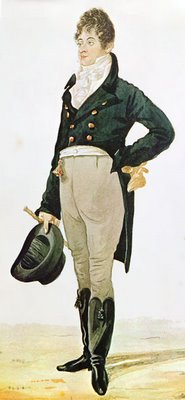 In The Corinthian, Georgette Heyer describes Sir Richard in her inimitable fashion:
In The Corinthian, Georgette Heyer describes Sir Richard in her inimitable fashion:"He was a very notable Corinthian. From his Wind-swept hair (most difficult of all styles to achieve), to the toes of his gleaming Hessians, he might have posed as an advertisement for the Man of Fashion. His fine shoulders set off a coat of superfine cloth to perfection; his cravat, which had excited George's admiration, had been arranged by the hands of a master; his waistcoat was chosen with a nice eye; his biscuit-coloured pantaloons showed not one crease; and his Hessians with their jaunty gold tassels, had not only been made for him by Hoby, but were polished, George suspected, with a blacking mixed with champagne. A quizzing-glass on a black ribbon hung around his neck; a fob at his waist; and in one hand he carried a Sevres snuff-box. His air proclaimed unutterable boredom, but no tailoring, no amount of studied nonchalance, could conceal the muscle in his thighs, or the strength of his shoulders. Above the starched points of his shirt-collar, a weary, handsome face showed its owner's disillusionment."
In High Society: A Social History of the Regency Period, 1788-1830, Venetia Murray writes:
"...admirers of dandyism have taken the view that it is a sociological phenomenon, the result of a society in a state of transition or revolt. Barbey d'Aurevilly, one of the leading French dandies at the end of the nineteenth century, explained: Some have imagined that dandyism is primarily a specialisation in the art of dressing oneself with daring and elegance. It is that, but much else as well. It is a state of mind made up of many shades, a state of mind produced in old and civilised societies where gaiety has become infrequent or where conventions rule at the price of their subject's boredom...it is the direct result of the endless warfare between respectability and boredom.
In Regency London dandyism was a revolt against a different kind of tradition, an expression of distaste for the extravagance and ostentation of the previous generation, and of sympathy with the new mood of democracy.

Also view:
Gentlemen's Clothing of the Regency Era
Men's Fashion from the Jane Austen Centre
Fashionable Gentleman prints
A biography of George Brummel
Menswear from 1790 to 1830

No comments:
Post a Comment